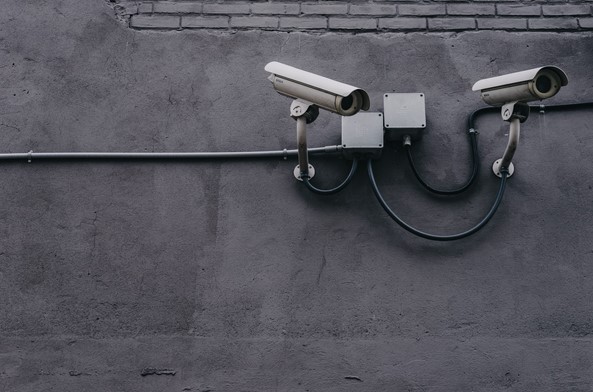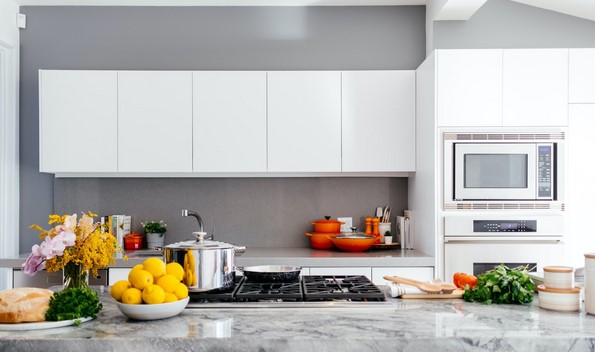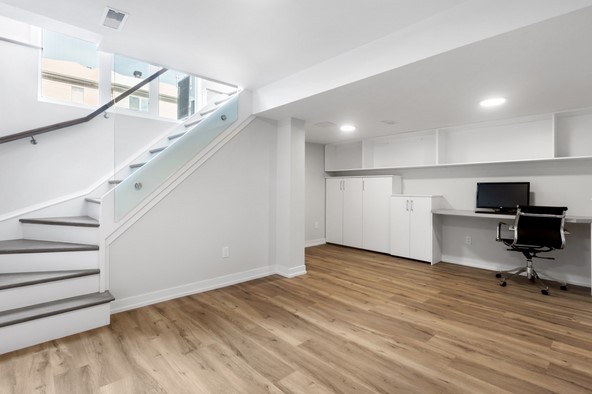When someone says “home safety,” you probably think of security cameras and an alarm system. And that’s a part of it, but there’s a lot more. Home is a place to relax, play, and enjoy spending time with your family. Don’t let accidents and serious injuries get in the way.
Some quick checks can prevent accidents, falls, and emergencies like fires. Make “Home Sweet Home” a “Home Safe Home” with these easy tips.
Kitchen
Check Your Appliances
Old or broken appliances are one of the biggest safety hazards in the kitchen. Give them a check from time to time. If you have a gas stove, make sure that the burners light properly. Keep an eye on countertop appliances like microwaves, air fryers, and crockpots—if they’re too close to the oven, their cords might melt.
Don’t Overload Your Circuits
Kitchen appliances use a lot of energy and might trip your home’s breaker. Plug in items one at a time to determine the culprit. Moving it to a different outlet might fix the issue, since a lot of kitchens have more than one circuit. If yours doesn’t and circuit overloads continue to happen, check with an electrician to install a new dedicated circuit and outlet
Inspect Drains and Garbage Disposal
Always make sure your kitchen sink is free from buildup or clogs. Don’t put grease or coconut oil down the drain, since it will harden in the pipes and cause leaks. A garbage disposal is a nice convenience but be sure that it is working properly. Don’t feed it starchy foods like pasta and rice, or hard stuff like seafood shells and fruit pits. And if you have little ones at home, please buy a switch cover that stops them from turning it on by mistake.
Baby-Proof Dangerous Items
Speaking of small children, make sure they can’t get to the sharp or poisonous items. Knives, scissors, and other utensils need to be out of reach or stored in cabinets or drawers. The same goes for dishwasher detergent and other cleaning supplies. Add child-proof safety locks or latches when you’re done.
Post an Emergency Contact List
We’re so used to our cell phones that we forget that they might not always be there. Think fast: what’s your sister’s phone number? In an emergency, every second counts. Be prepared so you don’t have to Google the poison control phone number or directions to the hospital. Tape an emergency contact list to your fridge. Include numbers of your local police and fire department, doctors, etc. Also include your own work and cell phone numbers, and family members and friends that should be notified in case of an emergency. FYI the Poison Control number is 1-800-222-1222
Bedroom
Invest in a Safe
A safe isn’t just a place to store jewelry or guns. You’ll never want to lose your passport, birth certificate, social security card, or insurance documents if there’s a break-in or fire. The TURBOLOCK TURBOSAFE even sends out phone notifications whenever the safe is opened or if someone tries to move it. Simply download the monitoring app for your iPhone or Android, and enjoy peace of mind.
https://turbolock.com/turbosafe-wifi-smart-safe-with-monitoring-app-tamper-alerts/
Examine Outlets and Switches
Damaged outlets can destroy appliances, shock someone, or even start a fire. Periodically check your outlets to catch an electrical problem early. If you plug something in, do the lights flicker? A buzzing noise? Outlet testers are cheap and can be found at your local hardware store. Also check the light switches and outlets for damage or signs of charring. Check for cracked or missing covers. Replacing them is super easy, barely an inconvenience. If you have toddlers, now is a good time to add childproof outlet covers to keep curious fingers away.
Test Smoke and CO Detectors
Smoke and carbon monoxide detectors are very important, and testing the alarms is rather simple. Check the batteries and test them every month, even if it’s not giving you the “low battery chirping noise.” The sensors inside go bad after 10 years, so now is a good time to replace anything left over from when “Call Me Maybe” was the song of the summer. Get some new fire extinguishers while you’re at it. The manufacturers are required to make the expiration dates really easy to find.
Bathroom
Check for GFCI outlets
Have you seen a power outlet that has two big buttons in the middle? That’s a ground fault circuit interrupter and it stops you from getting electrocuted. If cuts off power immediately if the outlet gets wet and you start to receive a shock. Newer homes always have these near sinks. But if you have an older home or the previous owner did some DIY updates, you’ll want to replace the standard outlets with a GFCI model.
Inspect Your Pipes
Look for signs of leakage, rust, and corrosion on and near your pipes. Check the bathroom faucets for drips or leaks as well. And since you’re already under the sink or by the toilet, check your shut-off valves. A shut-off valve turns off the water to just that one area in case there’s a leak. If the valve has a powdery green look and doesn’t turn easily, try cleaning it with a wire brush and vinegar. Then soak it with a lubricant like WD-40 or penetrating oil to loosen it up. But if it’s completely stuck, you’ll want to get it replaced.
Test and Clean the Shower
Check if the water pressure and the temperature is okay. Does it get blazing hot if someone flushes the toilet? Most major companies have an anti-scald guard on their shower faucets. This lets you increase or decrease the maximum water temperature without adjusting the whole house water heater temp. And if you notice that water pressure is low, try removing the shower heads and soaking them in vinegar or citric acid to remove mineral buildup from hard water.
Check the Caulk
Check the caulking around the tub, shower, and tiles. Make sure that there aren’t any cracks where water can get in and cause trouble. Clean any mildew and mold in the grout as soon as you see it. Mold loves warm, moist places like your bathroom. It loves eating the cellulose that’s in soap scum. And in just a few weeks, it can spread everywhere. Mold isn’t just gross to look at: it causes rashes, skin irritation, sneezing, itchy eyes, and breathing difficulty, especially in people with asthma or allergies.
Basement
Locate the Utility Shut-offs
Be prepared! Know where everything is in case of a plumbing leak or electrical emergency. The shut-off valves are often hidden in dark, creepy places you won’t visit often, like a basement, crawlspace, or a weird corner of the garage. Every once in a while, you may need to reset a circuit breaker (try running a microwave, desktop computer, and a portable air conditioner in the same room at the same time!) And if there’s a power outage, you don’t want to stumble through the dark to find the electrical panel.
Clean the Dryer Vent
Clean the dryer vent periodically. The lint trap doesn’t catch everything, and fuzzy buildup in the exhaust pipe can unexpectedly ignite. Dryer fires cause an astounding $35 million in property damage each year! And though it seems like a huge task that requires a professional, you can get a drill-powered cleaning kit for about $20 at the home improvement store.
Inspect your water heater
Check the water heater tank for signs of rust or leakage. Common locations for leaks include:
- At the floor level, under the water heater
- Under and around the relief valve
- At the piping to and from the water heater
Regularly flushing the water tank keeps your water heater in optimum condition. You’ll want to do this once per year. Flushing out filth removes build up and improves efficiency. Be sure to turn off both water and power to your water heater before attempting a flush. If you own a gas water heater, know how to care for the pilot light and venting system. Gas water heaters may require additional inspection and cleaning of the burner and ports.
Change Your Air Filters
Inspect your heating and air conditioning filter. Typically, air filters need to be changed every three months. A dirty filter restricts airflow, making your heating and cooling less efficient. And since your furnace has to work harder, the extra strain can cause it to fail. Also, air filters trap indoor pollutants such as dust, pet dander, and pollen. If you have allergies, it’s a no-brainer.
Outside
Install Alarm Systems or Security Cameras
Since we’re talking about home safety, you know we’d get here eventually. A home security system offers protection for your loved ones and property, as well as peace of mind. Many home security systems also integrate with your Smart Home, adding cool features like live camera monitoring on your phone, Internet-connected lights, and smart door locks and garage doors. Obvious signs of an alarm system, like stickers, yard signs, and outdoor cameras, are proven to scare off burglars.
Upgrade Your Lighting
Set the mood and keep your home safe with updated lighting. Illuminating walkways, driveways, steps, and porches help reduce the chances of accident or injury. A well-lit yard cuts the chance you’ll trip and fall, protects your home from intruders, and enhances your curb appeal. And outdoor security lights are an integral part of any home security system. Burglars are more likely to choose a home where they can lurk in the shadows. Smart LED lights include cutting-edge features such as motion detection, Wi-Fi on-off, and two-way audio to scare them away.
Check Your Fencing
Be sure that your fence is in good condition. If you have a wood fence, inspect your wood for warping, insects, rotting and landscaping damage. Any nails poking out? Is it going to fall over and hurt someone? Can a dog squeeze through damaged panels? How about a kid? This is especially important if you have a swimming pool. According to the CDC, drowning is the number one cause of unintentional death for children between the ages of 1 and 4. Does the gate close tightly and latch securely? Do the locks work properly?
Replace Old Locks
Speaking of locks…. Whether a lock is damaged, a roommate moved out, or you lost your keys, replacing your locks is the way to go. They are simple to install, and it gives you the opportunity to upgrade to keypad locks or locks with convenient smart home features. There are keyless options, Smart Home tech that you can lock and unlock with your phone, Bluetooth and Wi-Fi locks that keep an eye on things with an app, locks that use your fingerprint, and more.
Which lock is right for me?
Keypad Door Locks https://turbolock.com/door-knobs/
Smart Keypad Locks with App https://turbolock.com/smart-lock-door-knob/
Keypad Deadbolts https://turbolock.com/keypad-deadbolts/
Smart Keypad Deadbolts with App https://turbolock.com/smart-deadbolts/
How-To Guides
Making your home burglar-proof is easy! Here are some tips and tricks we’ve put together to make the installation easy and headache-free.
Conclusion
Protecting you and your family is Job #1. An occasional safety check can prevent unintentional accidents, injuries, and emergencies. Your family will be healthier and safer with just a little prevention. Some of these things aren’t obvious, and we hope that our safety checklist helped catch them. Thanks for reading, and have a happy, safe day!







